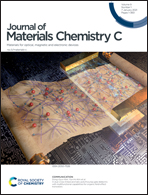Enhanced doping efficiency and thermoelectric performance of diketopyrrolopyrrole-based conjugated polymers with extended thiophene donors†
Abstract
The design of polymer backbones suitable for improving doping efficiency can provide a new direction in enhancing charge transport and thermoelectric performance. However, their optimizations are still unclear. Herein, the synthesis of a new diketopyrrolopyrrole (DPP)-based conjugated polymer with eight thiophene groups in a repeat unit, EHT6-20DPP, was reported for the improvement of thermoelectric properties. Compared to other DPP-based polymers with a different number of thiophene groups, EHT6-20DPP exhibits higher doping efficiency when doped with a p-type dopant, FeCl3, owing to its higher number of thiophene groups as electron donating units. The optimum electrical conductivity and power factor of the doped EHT6-20DPP were found to be 93.28 S cm−1 and 56.73 μW m−1 K−2, which are higher than the reference DPP-based polymer with three thiophene groups in a repeat unit. The relationship between the thermoelectric properties is demonstrated using a charge transport model, suggesting that doped EHT6-20DPP has good charge transport properties in terms of polymer backbone engineering. The results of the present work could provide insights into the optimal polymer backbone design for excellent thermoelectric properties.



 Please wait while we load your content...
Please wait while we load your content...